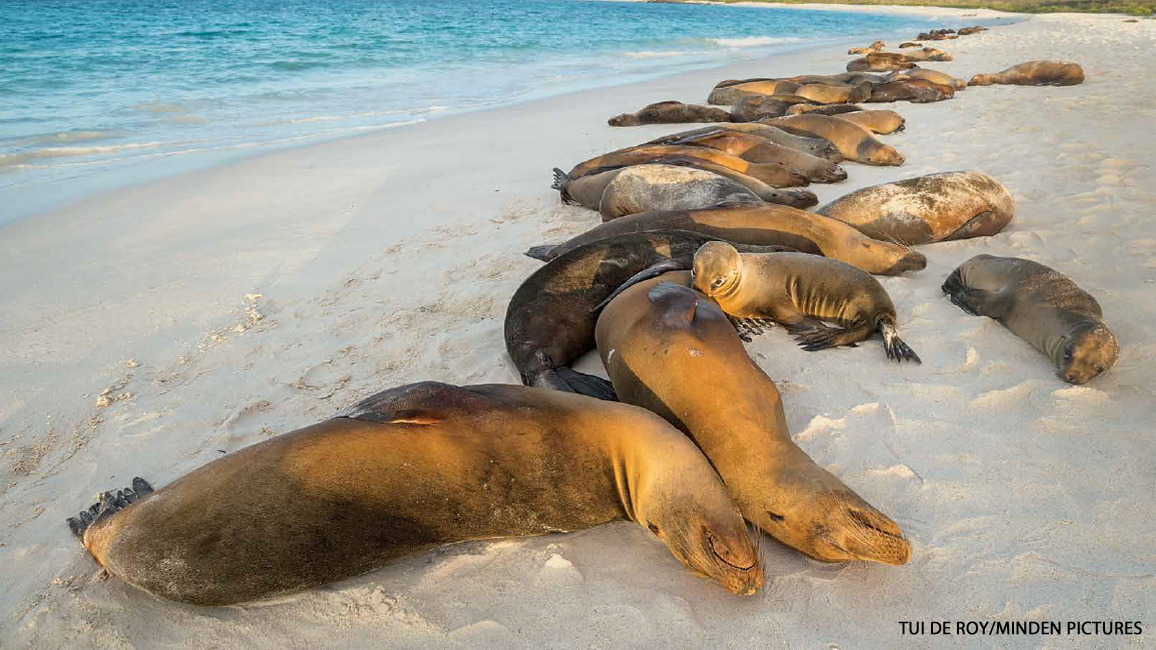
Beach Bums
By Kathy Kranking; Photos by Tui De Roy/Minden PicturesWhen it comes to chilling out, Galápagos sea lions are champs!

On a sandy island beach, velvety brown lumps lie in the sun. The only signs of life are a twitching whisker here, a lazy flipper scratch there, and a whole lot of snoring!
The lumps are sleeping sea lions—Galápagos (guh-LAHpuh- gohs) sea lions, to be exact. As you can tell by their name, they live in the Galápagos Islands, off the west coast of South America (see map). Like all sea lions, they spend a good bit of time resting on beaches or rocks. But that’s only part of their story. Because when they’re not lying around on land, they’re zipping around in the water! Keep reading to see how lively they can be.

WAVE RIDERS
Galápagos sea lions may be beach bums when they’re on land, but in the water they’re more like mermaids! Their torpedo-shaped bodies help them glide through the water. They’re very acrobatic, often flipping and spinning as they swim. And they love to “surf” by riding the waves in to shore.
Galápagos sea lions are also great divers. They make longer, deeper dives than any other kind of sea lion. They can stay underwater for up to 10 minutes!
These sea lions enjoy playing and frisking around with each other. But they also spend much of their time in the water looking for food. They eat mostly small fish. And not long ago, scientists learned that, in rare cases, some Galápagos sea lions will even work together to hunt tuna. They herd the tuna into shallow water near shore, where they’re easier to catch. Sometimes the fish will even jump out of the water onto shore to try to escape the sea lions. And that makes them even easier to gobble up!
These sea lions eat a lot: Every day, a big male eats more than a quarter of your weight in food. Males eat more because they weigh more than twice as much as females. Besides being bigger, a male also looks different from a female because he has a large bump on his head (see top of page 10).
VIDEO: WATCH SWIMMING SEA LIONS

BEACH BOSSES
Galápagos sea lions come ashore for more than just resting. When it’s mating time, a male stakes out a section of the beach as his own. He patrols the water in front, barking loudly. The barking is a warning for other males to stay away and also a way to show off to females. When females come ashore to mate, the male guards them, chasing away other males. The male works so hard keeping other males away from his “turf” that he often goes without eating.
Sometimes another male will challenge a male for his territory. Then the two may fight. During fights, there’s a lot of pushing and neck-biting. Males have very thick skin on their necks, which keeps them from getting seriously hurt during a fight.
PUP TIME
A mother sea lion gives birth to one pup at a time. For the first five days or so of the pup’s life, its mom stays with it all the time and the pup drinks her rich, warm milk. After that, the mom will leave the pup to go out looking for food for herself. While she’s gone, her pup stays with other baby sea lions in a “nursery” in shallow water.
The mom nurses her pup again when she comes back. Soon the pup will go out into the water with its mom, learning to swim and, eventually, to catch food. Pups may stay with their moms for one to three years.
LOVABLE LIONS
Sea lions are some of the most famous animals on the Galápagos Islands. People love them, and the animals seem very comfortable around people. These sea lions often sleep on docks or benches, crawl into boats, or come right up to people on the beach or in the water.
There is some bad news, though. Galápagos sea lions are endangered. There are a number of reasons for this. Because of climate change, the waters around the Galápagos are warming up too much. And that means fewer fish for the sea lions to eat. Another problem sea lions face is that they sometimes catch diseases from other animals. And they also can get caught in fishing nets.
But the good news is that a lot of people are working to save these popular animals. They hope to always have them living in the Galápagos—lounging on beaches, diving deep, and riding the waves.
















